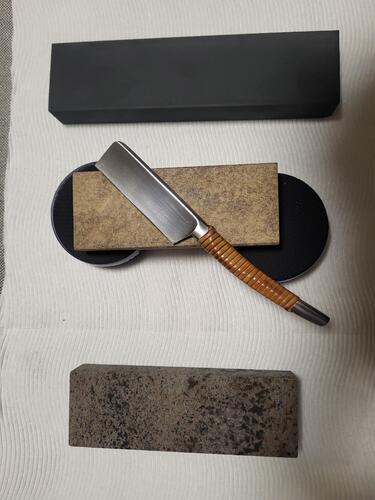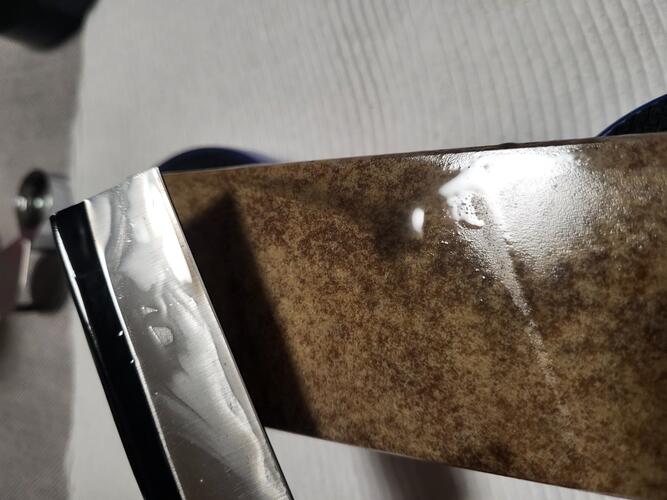Results 41 to 50 of 57
Thread: washita confusion
-
11-16-2017, 02:20 AM #41Senior Member

- Join Date
- Sep 2013
- Location
- NW Indiana
- Posts
- 1,060
Thanked: 246
It will be difficult to make generalities about these stones via personal experience, as none of us has had exposure to a significant number of stones compared to the number that were produced. My comments were based on geological reports from men who were actually at the mines when the stones were produced and what information they related from the miners themselves.
If you want to do better than that you're going to have to check the individual stones you receive yourself. You'd need to clean the stones very well (I use a heated ultrasonic bath using Simple Green as the bath liquid) so that they can properly absorb water. Then soak them and periodically weigh them until they stop gaining weight. Record that number and then dry them until they stop losing weight, and again record that number. Compare and check what percent of their dry weight in water was absorbed. Compare to the numbers I related earlier and you'll know what end of the spectrum your stone is from.
There is probably no reliable way to tell whether the stone will be on the softer/less dense or harder/more dense end of the spectrum by looking at photos or labels (short of the ones with end labels that actually say "Soft") before purchasing the stone.Last edited by eKretz; 11-16-2017 at 02:37 AM.
-
11-16-2017, 02:24 AM #42

Marketing?

All these terms and descriptions are to make you buy their product.
Even today with all these supposed rules in place this can be confusing!
-
11-16-2017, 02:54 AM #43Senior Member

- Join Date
- Sep 2013
- Location
- NW Indiana
- Posts
- 1,060
Thanked: 246
Aside all the other comments, Lily White is basically the "premium" level stone. If you can get one of those, get it. They are very nice stones. There definitely is some range of hard/soft and fine/coarse no matter the category though. Most of the Lily Whites I've run across are fine enough to produce a very nice edge for the speed that they cut. #1's will be very close to a Lily White with some possible irregularity of pore/grit size or inconsistency in coloration etc. The higher the number the more irregular/lower quality the stone and often coarser as well. You can sometimes see irregularities in the surface before purchasing if you have good photos - look for any weird patterns or banding. Strive for the most regular and uniform appearance.
-
The Following User Says Thank You to eKretz For This Useful Post:
Steel (11-16-2017)
-
11-16-2017, 03:17 AM #44Junior Member

- Join Date
- Apr 2017
- Posts
- 25
Thanked: 15
as thread title says: "washita confusion"

thanks guys
-
11-16-2017, 07:27 AM #45

I think you are making things way more confusing by taking comments made out of context and bunching many statements together that are talking about different things. You are over thinking this and making it harder than it needs to be. Add to it, that you have many questions all at the same time trying to be answered by different people all in one thread and it’s no wonder you are confused.

Last edited by Steel; 11-16-2017 at 07:32 AM.
What a curse be a dull razor; what a prideful comfort a sharp one
-
11-16-2017, 11:36 AM #46

With naturals, the only answer is to buy several, find what works, sell off the others or use them for kitchen knives.
Once you do that, you'll understand why the answers to your questions are all over the place.
Also be aware that vintage stones and boxes do get mixed up. Some by accident, some on purpose by unscrupulous sellers.
-
11-17-2017, 03:07 PM #47Senior Member


- Join Date
- Jul 2011
- Posts
- 2,110
Thanked: 459
The bottom line with the washitas is that all of them will finish a razor if you break them in. I never do any more with them than flatten them, but that can be involved if there is a lot of sway in the back.
I'm pleased that someone saw my video and decided to buy a washita, though. The lower density (more desirable) soft lilywhite have a softer more open feel, but they will finish nicely once settled in. The harder and more dense finer stones, same thing.
It's up to you if you pay a lot and get a labeled stone like a lilywhite. I think anything over high double digits is overpriced, but there are a lot of people selling labeled stones for close to two bills. Their capability vs. any unmarked stone that I've gotten is not anywhere near that ratio (actually, the only stone I absolutely didn't like was a stone that was labeled behr manning with no grade (just "washita oilstone"), and it probably actually would've been decent for , and both of my favorite stones (one for razors, one for tools) are unlabeled. I've had about ten labeled stones and probably between 30 and 40 unlabeled stones. I can usually find a decent stone (if I don't mind flattening each) for about $40 + shipping, but I have found dirty labeled stones as low as $18, and I did buy one oversize unlabeled stone for $100 (but I wouldn't suggest it. I lost money when I resold it).
I never buy a stone not to use, and since there is no practical difference between any of them for razors once a stone is settled in, I would just make sure it's a true washita, and avoid something with roughed up edges, because it'll catch spines and edges.
-
The Following User Says Thank You to DaveW For This Useful Post:
Disburden (01-02-2018)
-
01-06-2025, 05:30 AM #48

This method absolutely works. Not sure if you'll read this but thank you for your washita routine. 2nd shave and it was a real smooth shave.
-
01-07-2025, 03:15 PM #49

Thanks for resurrecting this old thread. Interesting stuff and lots of water under the bridge since then. Funny that most people think you're a nut or over dedicated to futility for wanting to do full Ark progressions these days. It is, or can be somewhat time consuming but well worth it IMHO. There are tricks to make it faster. I have a method I use which I have posted in a couple of places which actually goes fairly quickly.
But that's not even what I came to post about. Although this thread was pretty thorough one thing is curiously missing and that is mention of the elusive calico Washita. Funny, from what I've read these were a sort of red headed stepchild and at one time at least considered subpar to the lily white and No 1. This is likely because they were prone to voids and inclusions and may be why large ones are hard to find. Pity because they are very fast cutting and minimize the time investment of an ark progression. I use it first, then the No 1, then the lily white (sometimes, often I skip this stone. My No 1 and L/W largely overlap) and finally the black. When used on the right blade like a good midcentury American it leaves a fantastically keen edge. This edge is actually a little too crisp for some folks and can actually abrade/exfoliate your face with too much pressure or excessive strokes. To "tame" it for folks who like more skin friendly edges I normally follow it with a few (less than 10) light dry strokes on a fine coti. Personally I like an edge as keen as possible and use light pressure.
I have also always thought it odd that people and in fact the industry considers the Arkansas and Washita as two different stones. From an industry perspective I get this because, for functional purposes they are different at least in terms of usage. That said, so are the different classifications of Ark, i.e. soft-hard-black aka surgical black. Washita stones ARE an Arkansas stone. They are both novaculite with ranges of grit size and density. The main difference and what sets Washitas apart is the porosity of the particle matrix. This makes the use of varying pressure/torque against the stone make an enormous amount of variation in the striation effect even more than most other stones. It also broadens the range gained by the burnishing effect over an Ark.
Here is a good reference from the USGS, the 1890 annual report:
https://www.geology.arkansas.gov/pub...l-reports.html
Edit: Oh yeah, forgot to add pictures:
This is by far my best calico and my go to for heavy lifting at bevel set. It is also a favorite as an heirloom, inherited from my father. It is small but cuts fast and is rather fine for its speed.
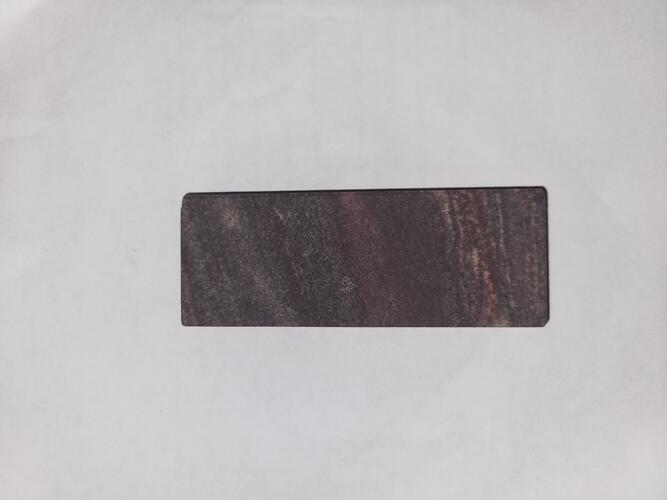
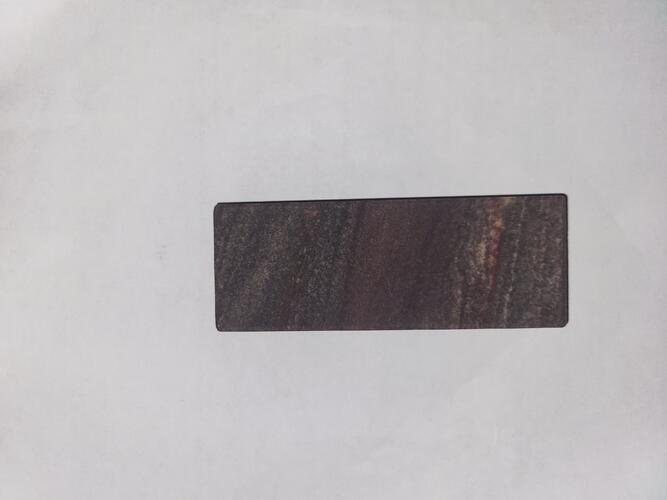
Here are a couple of others, not as good but still good. Both are more coarse than the first but don't cut as fast. The right one obviously a Buck, the left one marketed by Brookstone.
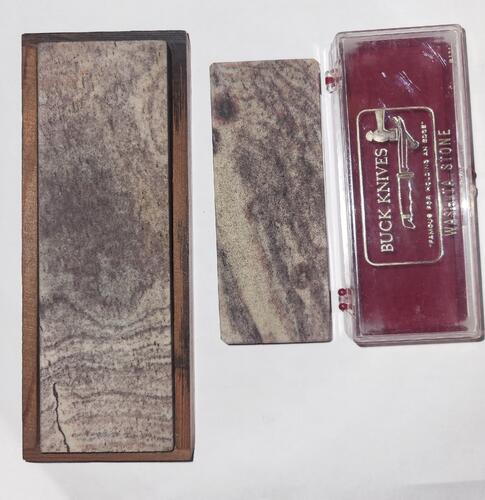
You can see why they are called "calico," or "mottled," from the varied coloring. Also you can see one of the inclusions I mentioned in both, primarily the dark spot on the Buck stone. This one is not that bad. Some have big pot holes in them.Last edited by PaulFLUS; 01-07-2025 at 04:02 PM.
Iron by iron is sharpened, And a man sharpens the face of his friend. PR 27:17
-
01-08-2025, 05:40 AM #50


 41Likes
41Likes LinkBack URL
LinkBack URL About LinkBacks
About LinkBacks






 Reply With Quote
Reply With Quote

